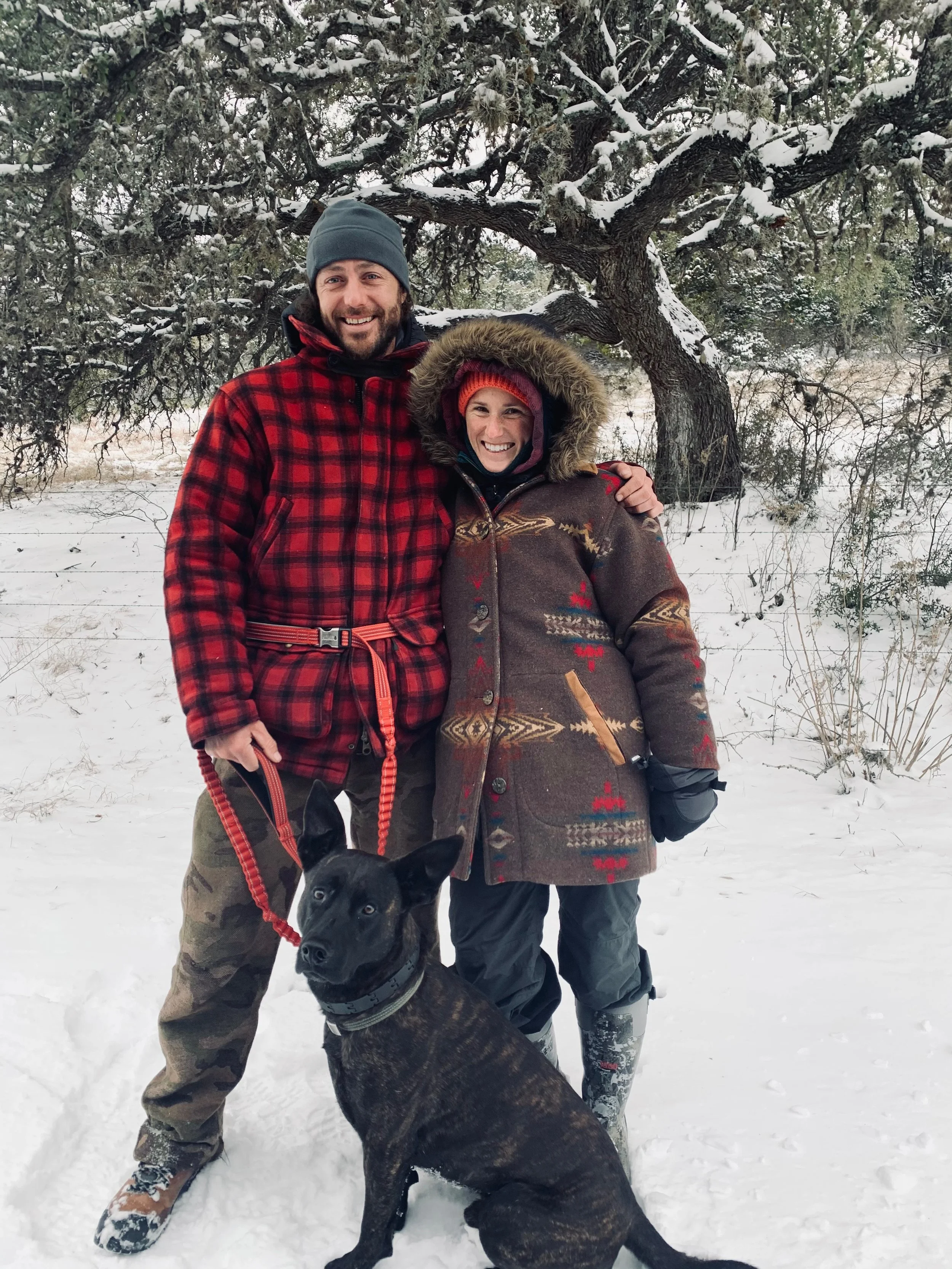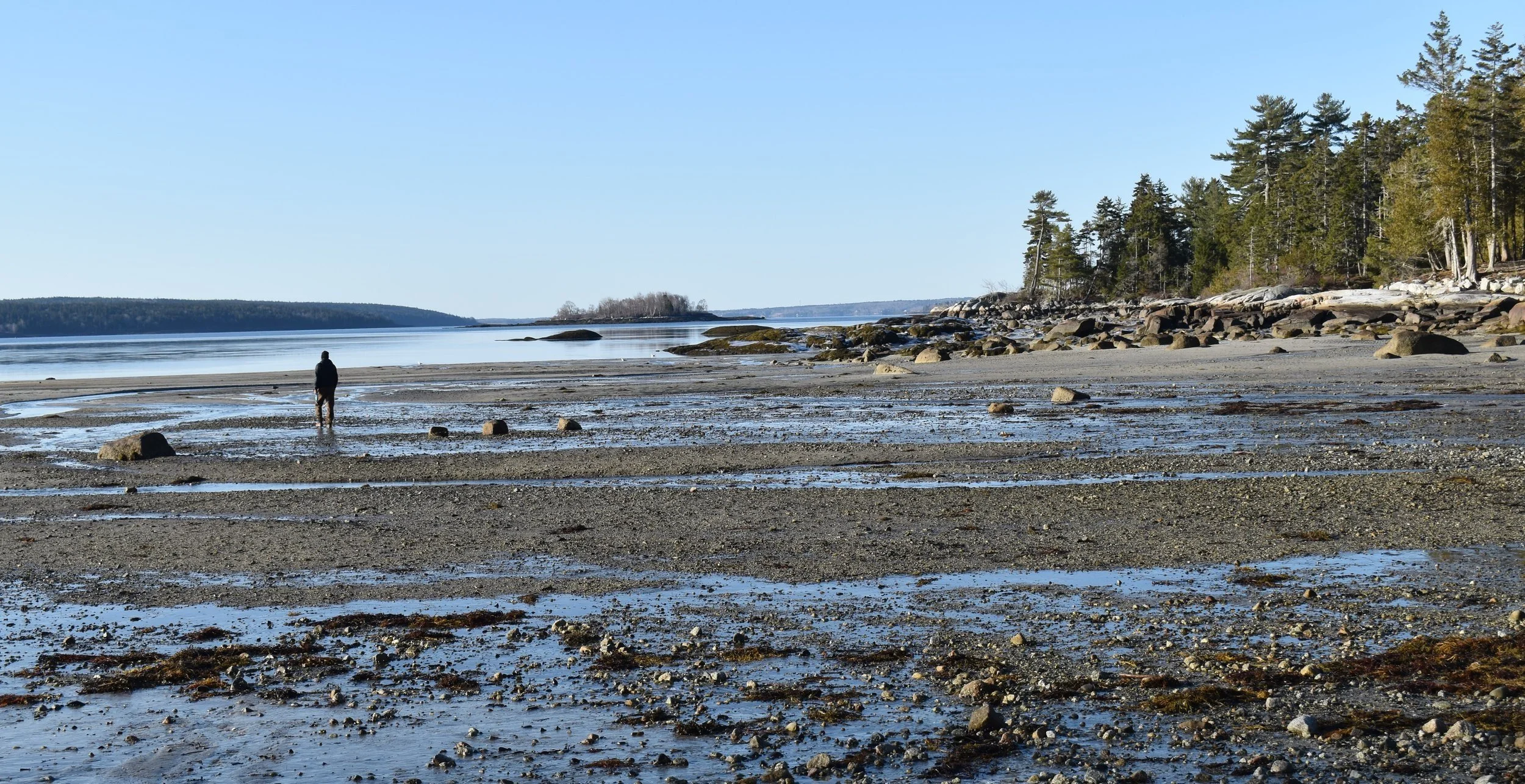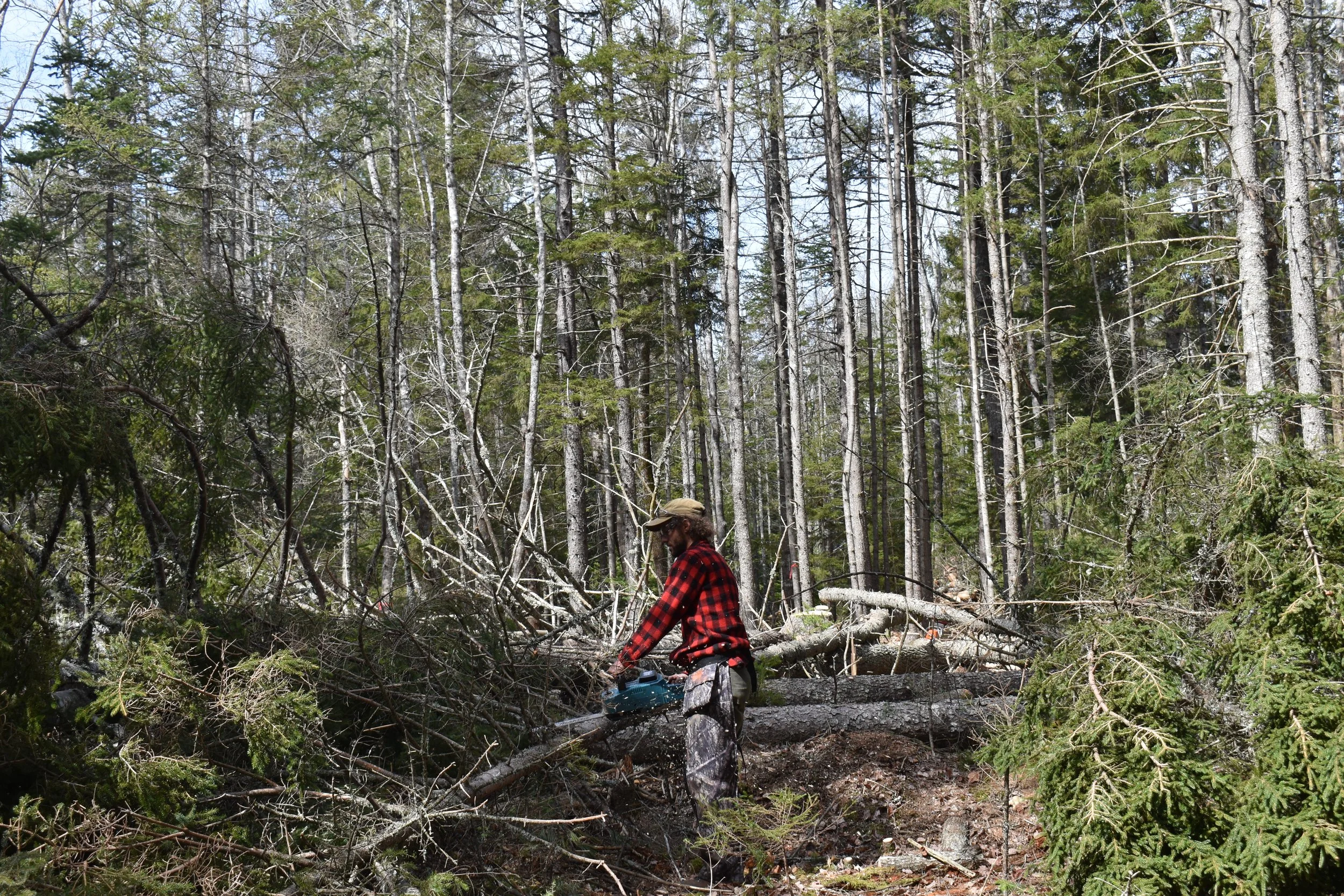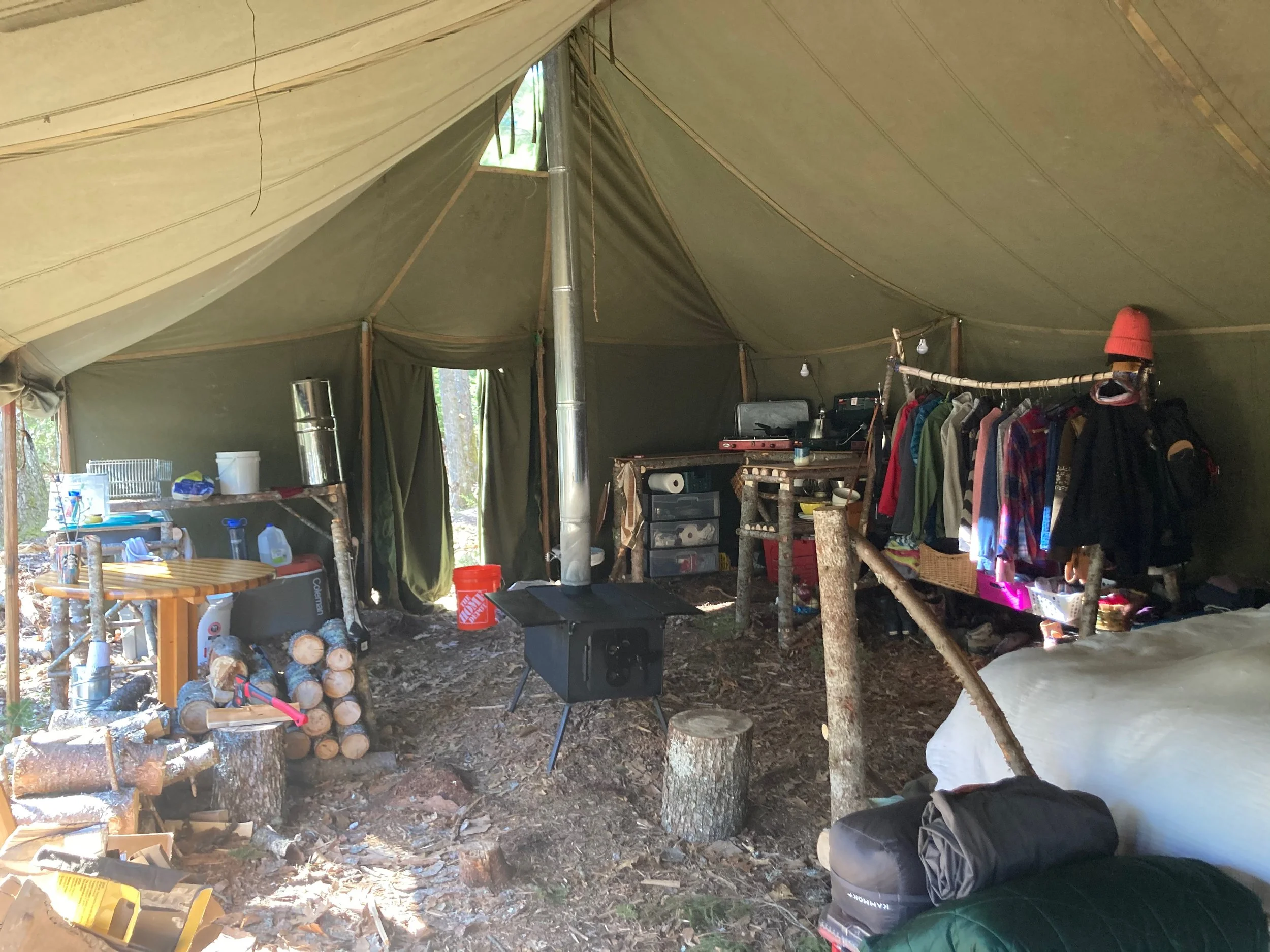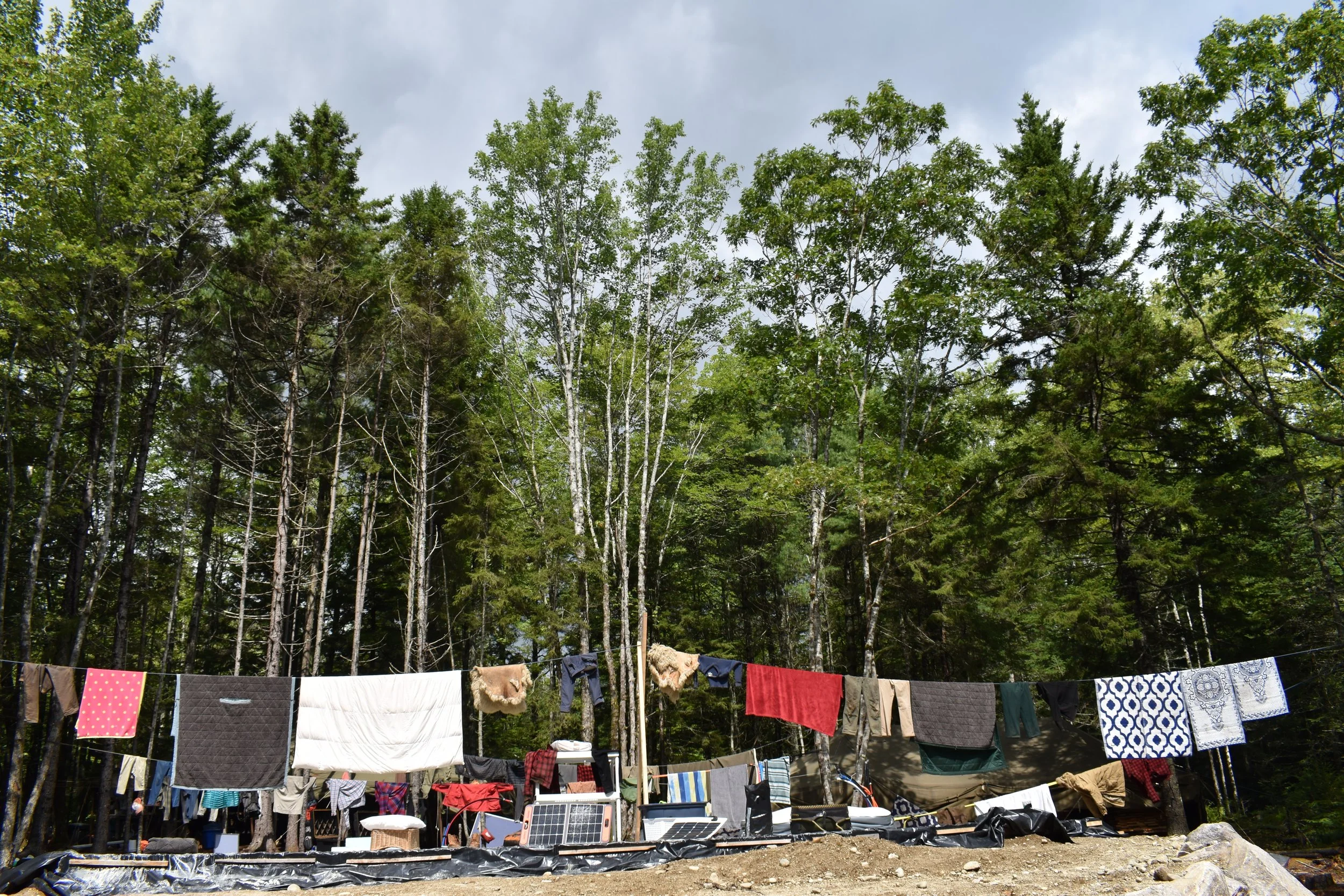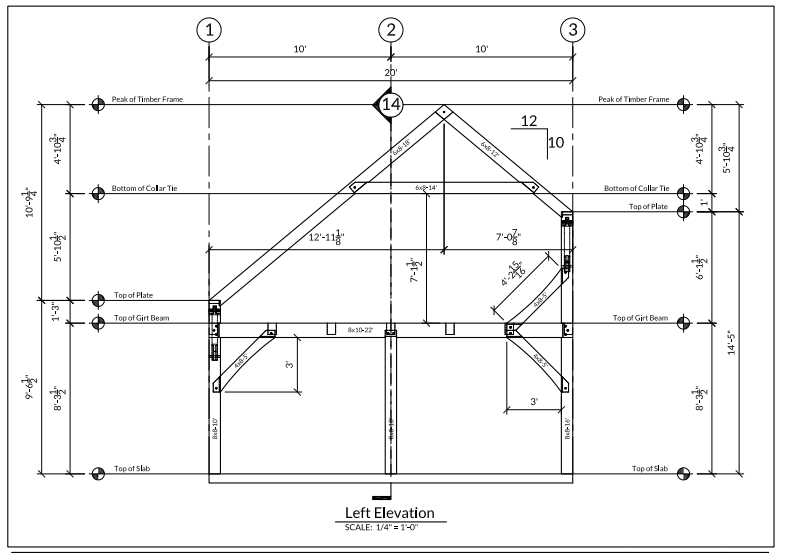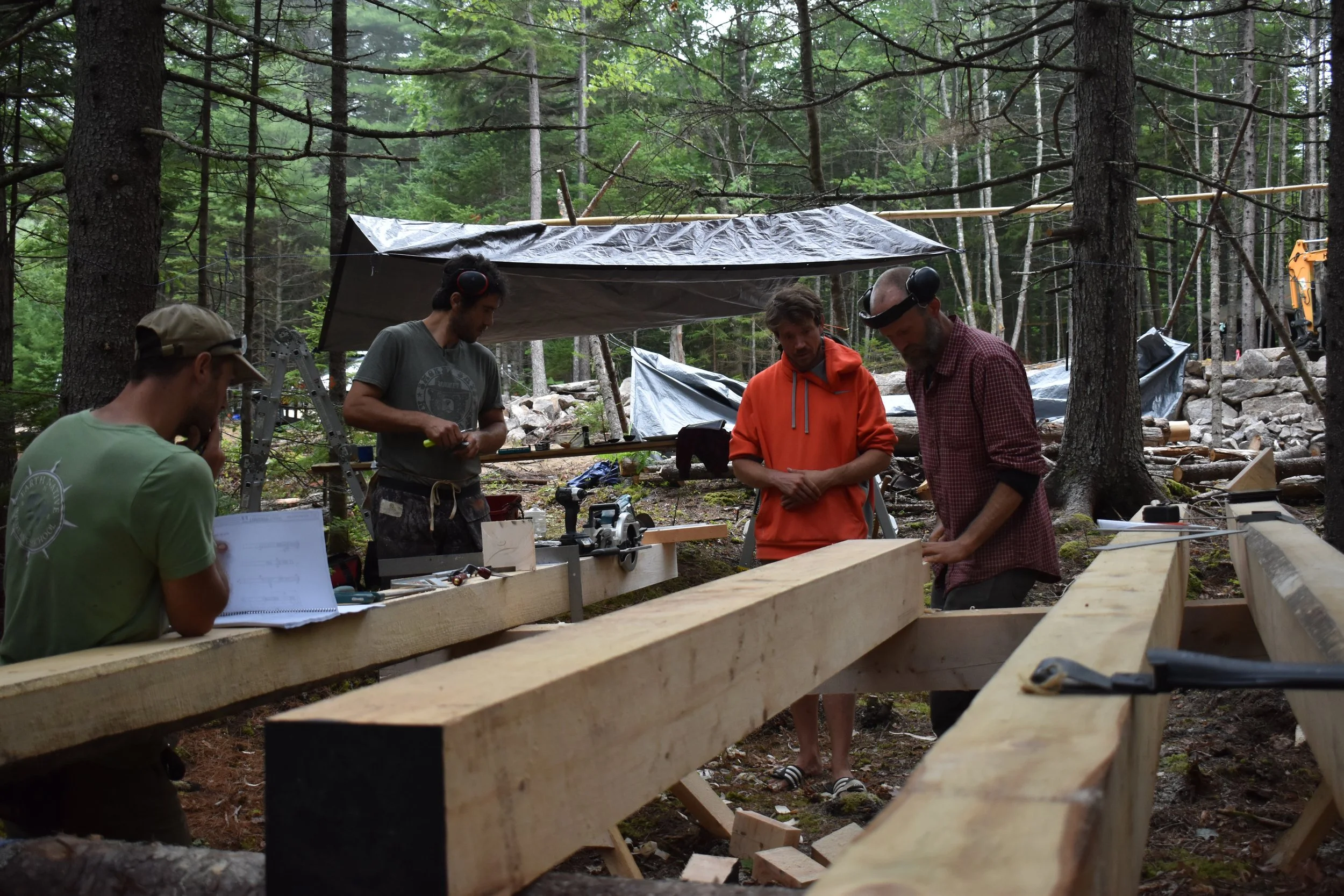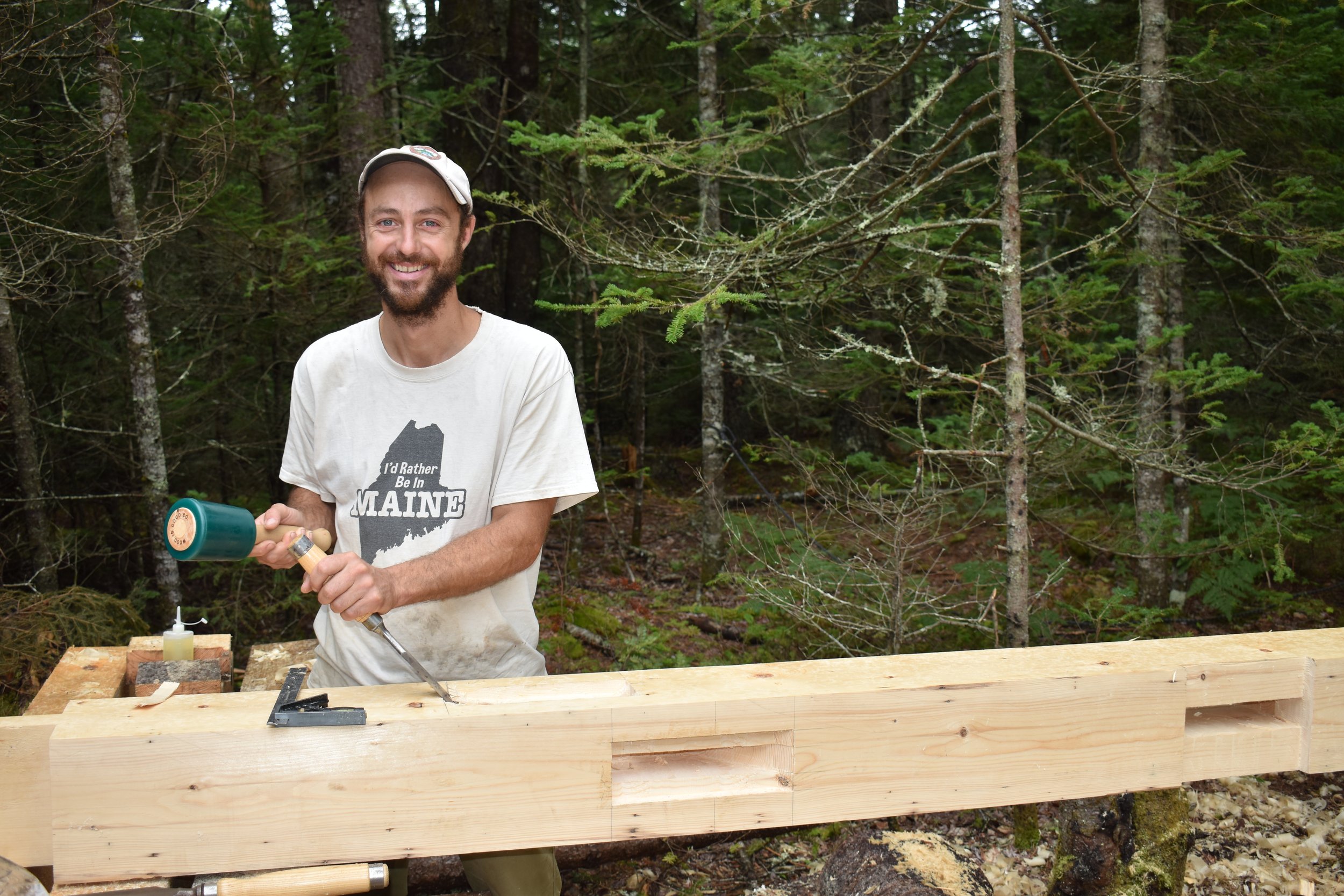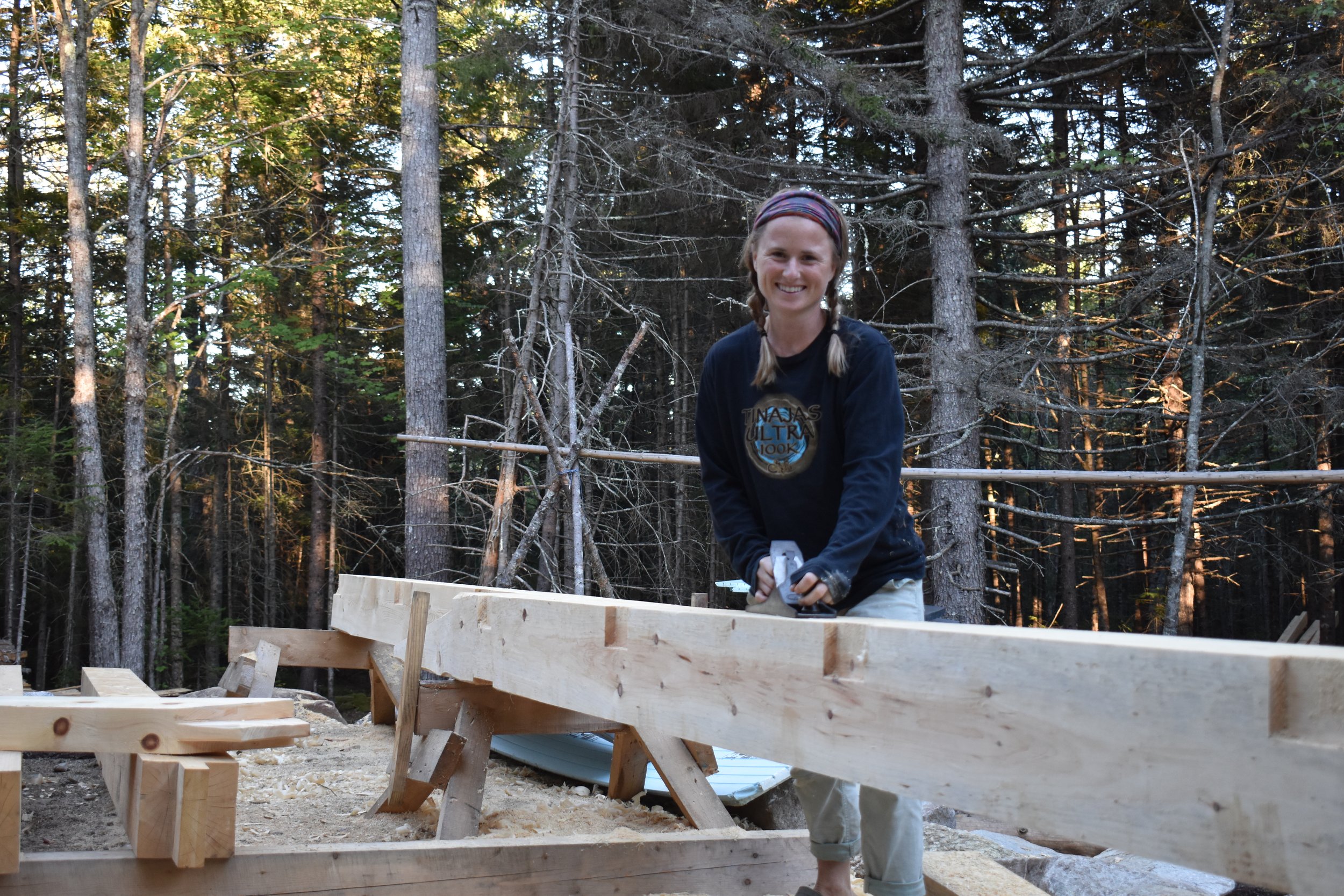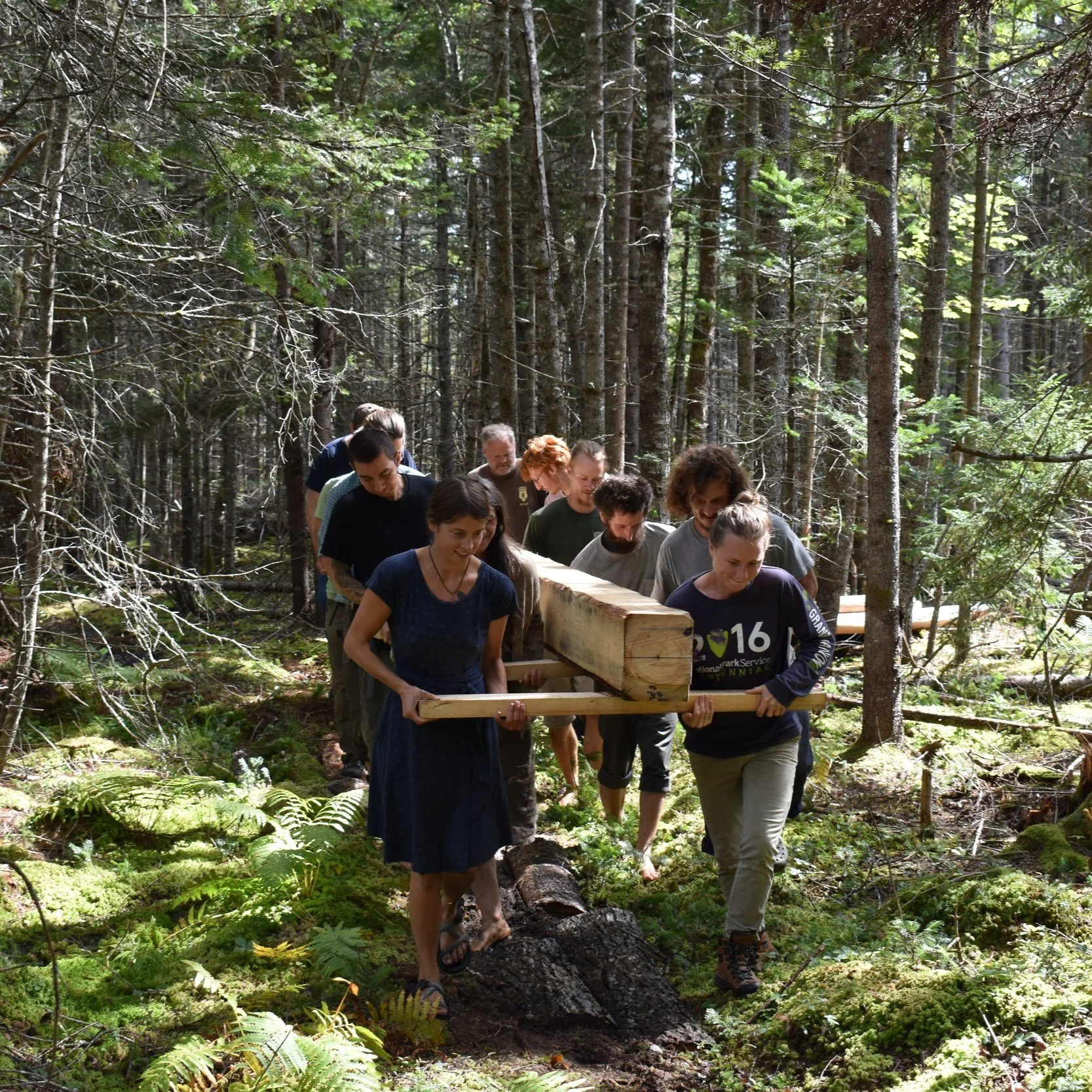12 min read
Mike & Amanda Build a House
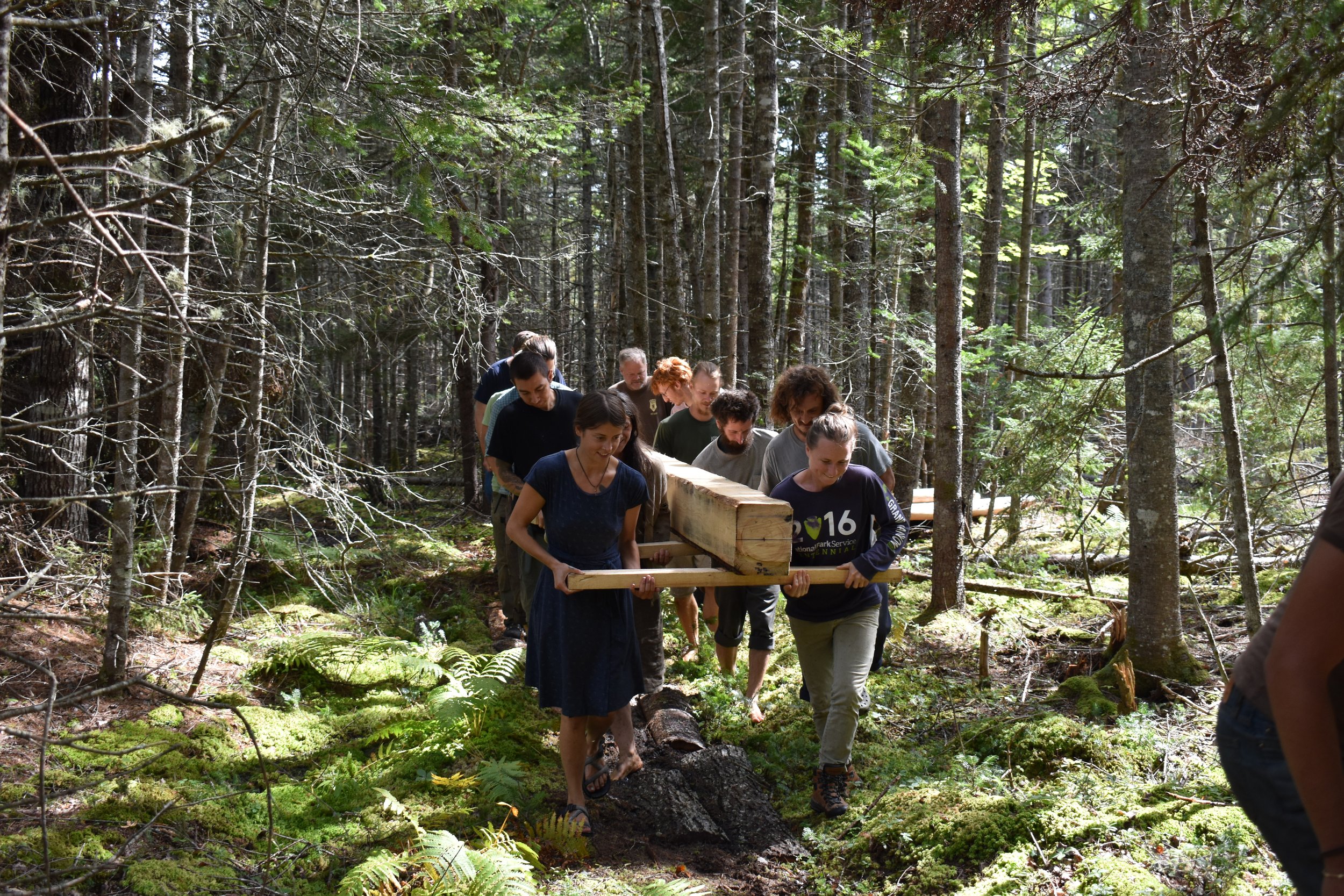

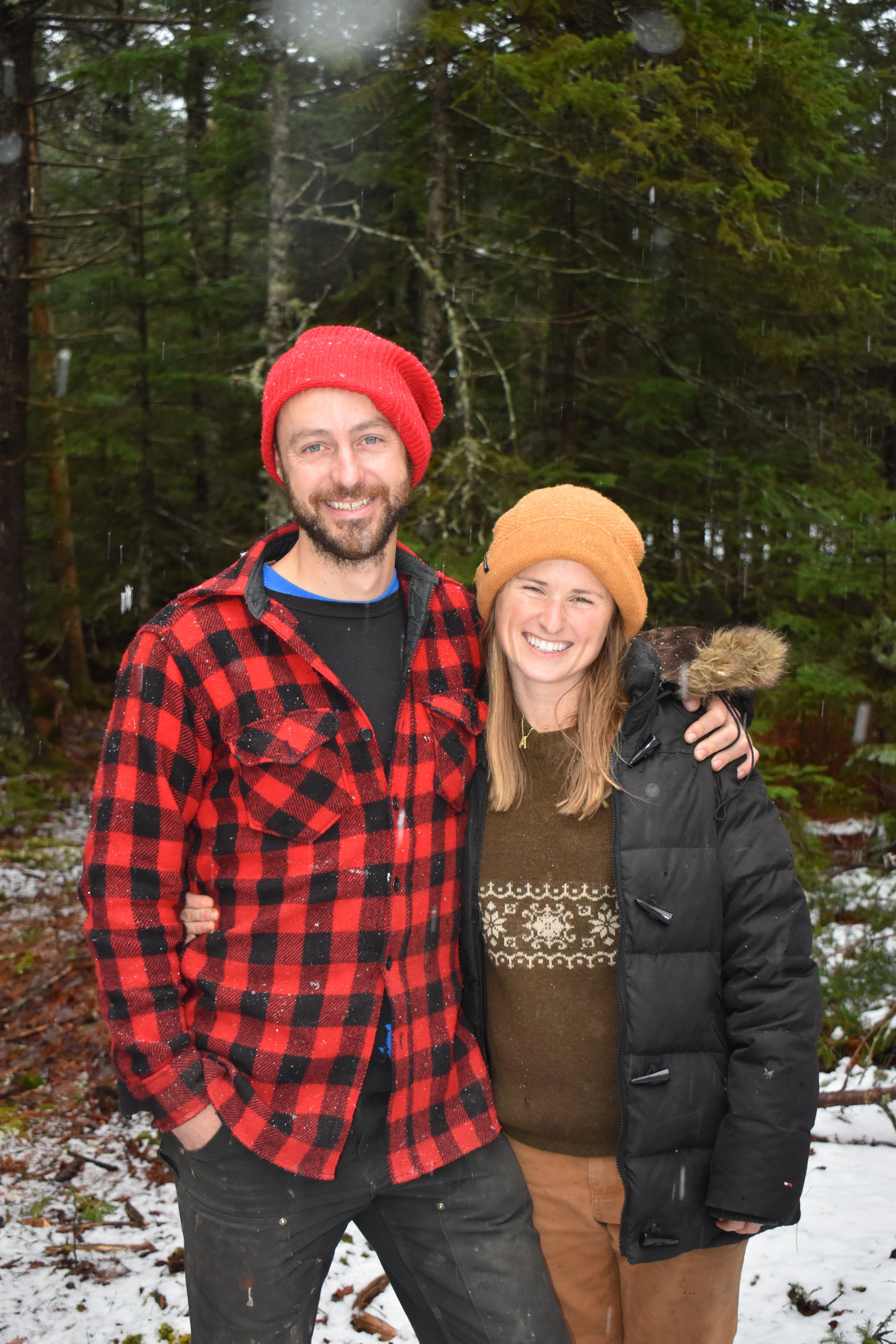
March 2021
We double-checked the weight capacity and repacked the car three times before getting the Tetris puzzle to fit. The truck bed overflowed as we pulled out of the driveway with any gadget we reasoned might be useful in building a house on a wooded plot 30 hours away. Mike’s home-building experience was limited. Mine was nonexistent.
In the first days of 2021, I sold nearly everything I owned. Over 30 years of accumulation was repurchased for a grand total of $400. Much more of it had to be given away. A few keepsakes were deposited in my childhood closet. One box of clothing was packed into the one vehicle we planned to take to Maine. Mike and I shared a bin of kitchen items and camping gear. Every other cubic inch of car space was reserved for the ever-growing collection of tools. HGTV meets lumberjack: chainsaws, power drills, axes, hatchets, a chop saw, an excessive amount of ratchet straps, and an even greater quantity of rope.
The feeling of material purging was not one of emptiness, yet the unknown we were stepping into was too vast to evoke freedom either. I found myself simply untethered. We were embarking on the biggest adventure of our lives with little more than a loaded Tacoma and the culmination of past experiences. We planned to put our life savings into creating a house out of trees while living in a tent in a rural forest. If there was a road map for this kind of journey, we didn’t find it. At the same time, we were carried by the intense energy of dreams, with the universe conspiring in our favor. We were met with countless green lights in purchasing the land, relinquishing jobs and leases, finding temporary accommodations, and tremendous support from friends and family.
I have long sought solace among the trees, often finding it easier to make sense of the forest’s trails than my own career path. Still, I let years pass in the confines of an office cubicle, glued to a computer screen, while my insides craved a greater sense of space and slower rhythms. Like many people, I daydreamed of a simpler lifestyle, maybe in a small, tucked away cabin. As work demands increased, my outdoor adventures kept pace, growing bolder, farther, longer. But, my relationship with the natural world never progressed beyond intermittent recreation until I met Mike.
Mike is different. He didn’t respond to his nudge with baby steps. He went all in, immediately. After college, six months working as an accountant was enough to send him into the woods for six straight years. Continuously, he put himself in survival situations to learn his shortcomings in the wilderness. He was determined to experience the fullness of nature while pushing his whole being within it. He was resolute in pursuing his dreams. For Mike, our present journey had always been a clear vision. It was only a matter of when. There was the economics to figure out and me to convince.
A year into the pandemic, we were not alone in reevaluating our lifestyle. We shared an urge for security through land ownership and space to practice the life of our choosing- one of simplicity, in deep connection with nature. In a time of such uncertainty, we set out to write our own narrative of stability, prioritizing well-being and rooting in a like-minded community.
Our friends and future neighbors connected us to the owner of a property that was not on the market. To our surprise, she accepted our offer. Communications were quick, and the transaction was seamless, so we dramatically expedited our timeline. Within two weeks of being property owners, we were living on the land.
Our new home was primitive, to say the least, dirt road, densely forested, no power, no water, no septic. Our short-term shelter (if you consider eight months short-term) was an enormous military tent gifted to us by Mike’s mentor. I felt like a pioneer.
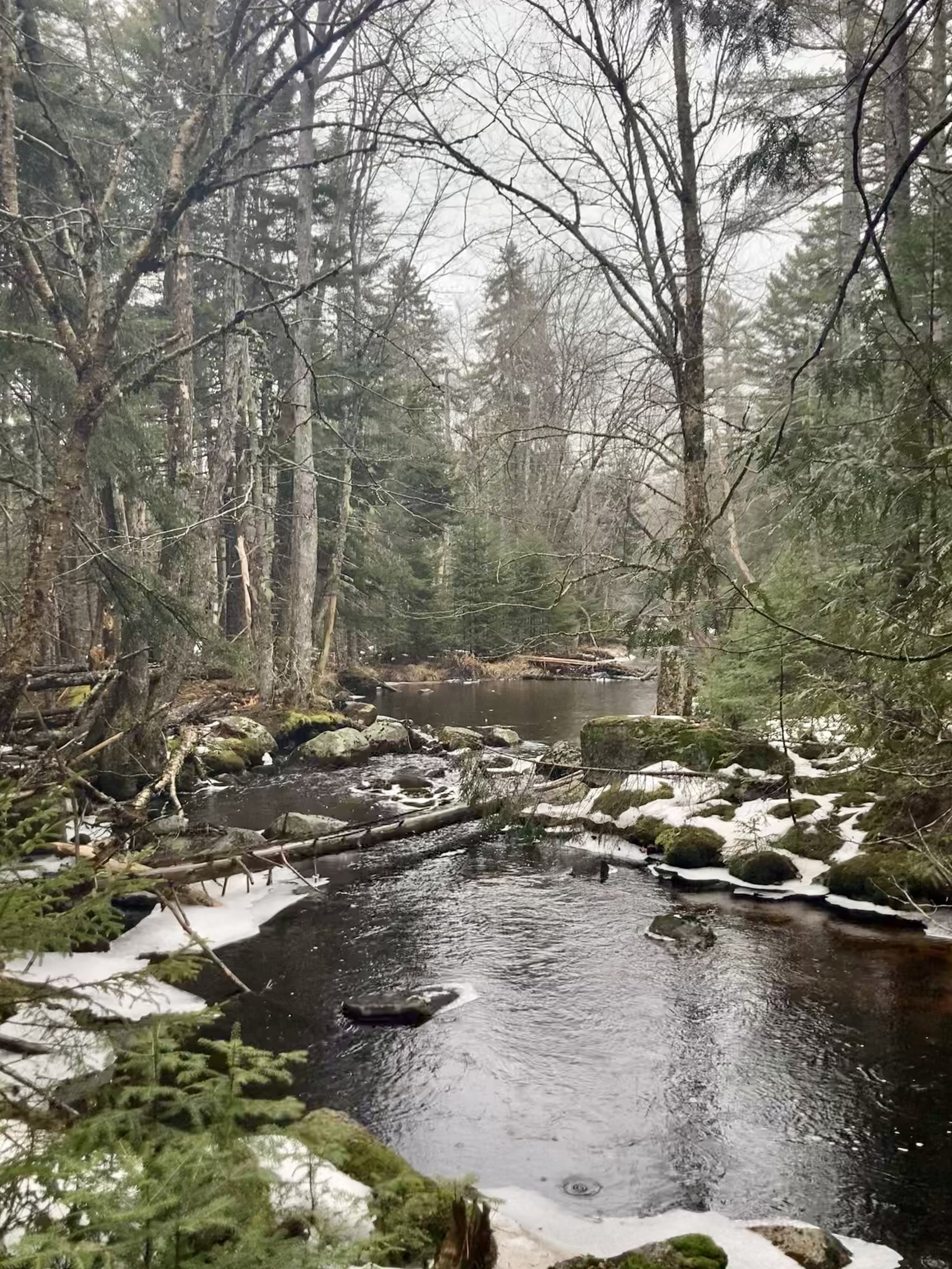
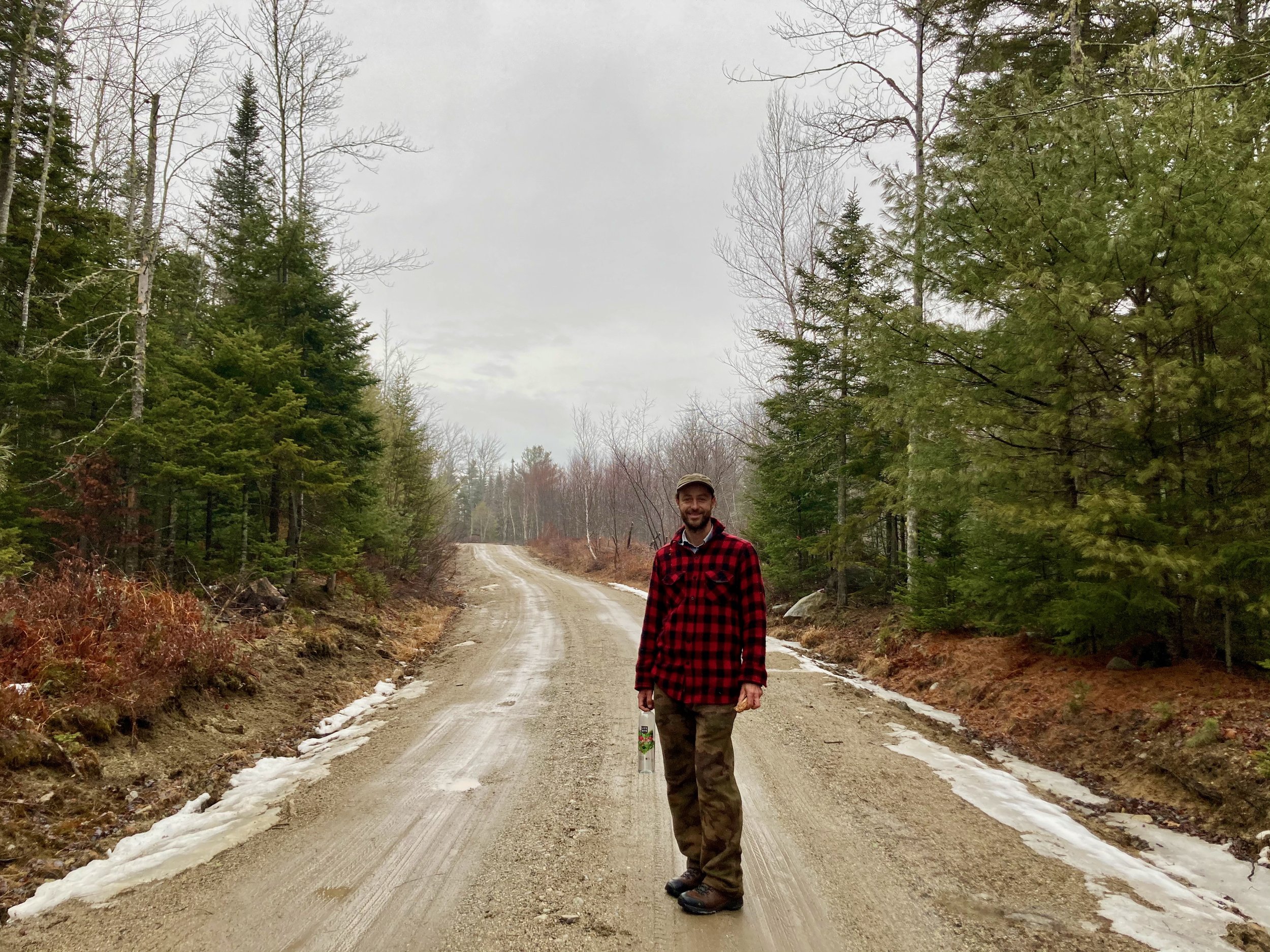

Mike was instantly at home in coastal Maine, but I struggled a bit more during the early weeks. I lacked the depth and longevity of Mike’s outdoor living experiences, which to be fair, is a resume few share. He once passed a Maine winter in a teepee and another in a canvas yurt. And when we first met, Mike had just moved into a remodeled chicken coop, which was a big step up from his previous year’s accommodations – a hole in the ground (but seriously!).
For me, there was an irony to feeling homesick while creating the very thing that was supposed to represent a forever home. But Texas was still in my bones, and so were the memories of the immediate sense of place I experienced there. Love in Maine happens differently, more stoic than emotive, with rugged coastlines, protected bays and forests that are frozen for many months of the year. In Maine, love is learned through hard work and time. I still needed some time.
We arrived in March, which is perhaps the drabbest time of year in Maine. The fickle weather was eager to test my limits from the beginning. The very first night, bitter winds pounded our fabric walls. Mike set an alarm clock for every two hours, ensuring he would wake in time to add another log to the fire. Unpracticed in the simplest of cold weather skills, I felt helpless. And very far away.


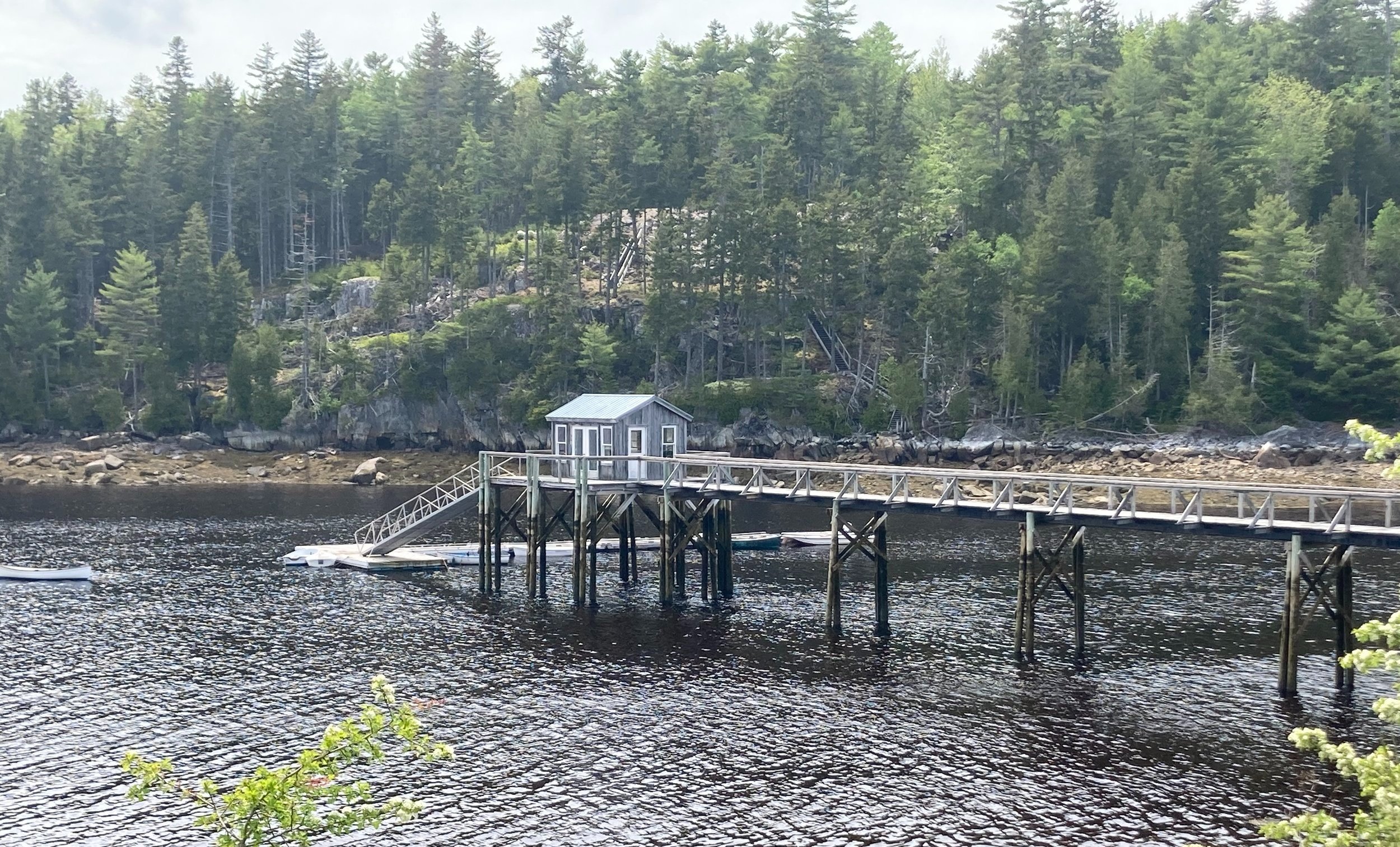
Daily visits to the ocean helped to soften the transition. We enjoyed secluded coves to ourselves as waves glittered in the morning light. On clear days we called out to the mountains of Acadia in the distance, their peaks the first viewers of sunrise in the United States. I learned that the native peoples who first stewarded this land are called Wabanaki – “People of the Dawnland.” There seemed to be something symbolic about returning East to begin our dreams.
Mike and I were no strangers to taking on crazy, stupid, wholehearted adventures, but neither of us had ever attempted anything quite to this magnitude. Every day pushed us to our limits for the better part of a year, while I rode a constant rollercoaster of emotion. The cliff notes versions went something like this:
Day 1
WTF! We purchased 13 acres of raw land, which for me, were sight unseen. From 2200 miles away, I had imagined a more inviting scene. Reality was a bit more… well raw. Like the start of any good adventure, it was raining when we arrived with temperatures hardly above freezing. I was hoping to explore the forest, but the trees were so dense that walking only a few steps inward brought a quick sting of branch slaps to my face. I was completely disoriented; every direction looked the exact same. We unloaded the car right there, stacking bins of tools under tarps in a small opening between the thin trunks of maple, birch, and fir, our pile of belongings looking painfully meager against their new backdrop.
Day 2
Like my other ungrounded fantasies, I imagined taking time to simply be with the land before making alterations to it. In sitting and walking with the forest, I hoped it would reveal itself to me - where to build and what type of structures to create. But the tangled mess of trees didn’t seem too keen on telepathy, and Mike kept reminding me that “Winter is coming” (even though I am pretty sure the previous one hadn’t ended). So, we agreed that cutting footpaths was an appropriate way to learn our new home, and Mike spent last night in the library’s parking lot, bumming internet to watch YouTube videos on how to use a chainsaw.
Week 2
Mike found inspiration in a 1920’s boy scout manual for constructing rudimentary furniture from sapling poles to outfit our tent. We assembled kitchen counters and shelving, a bed frame, clothing racks, and a workbench using little more than a chainsaw. We scavenged a few items from a neighbor’s junk pile, one trip to goodwill, and 2 pieces of plywood. For $250 we had a home 3 seasons home!


The daily discomforts were responsible for many moments of doubt, especially as I passed through a difficult period of redefining independence. Having swapped a career for days spent fetching water, splitting wood, washing dishes, and cooking meals over a two-burner Colman stove, I often felt invalidated. I smelled terrible and pooped in an open-air bucket.

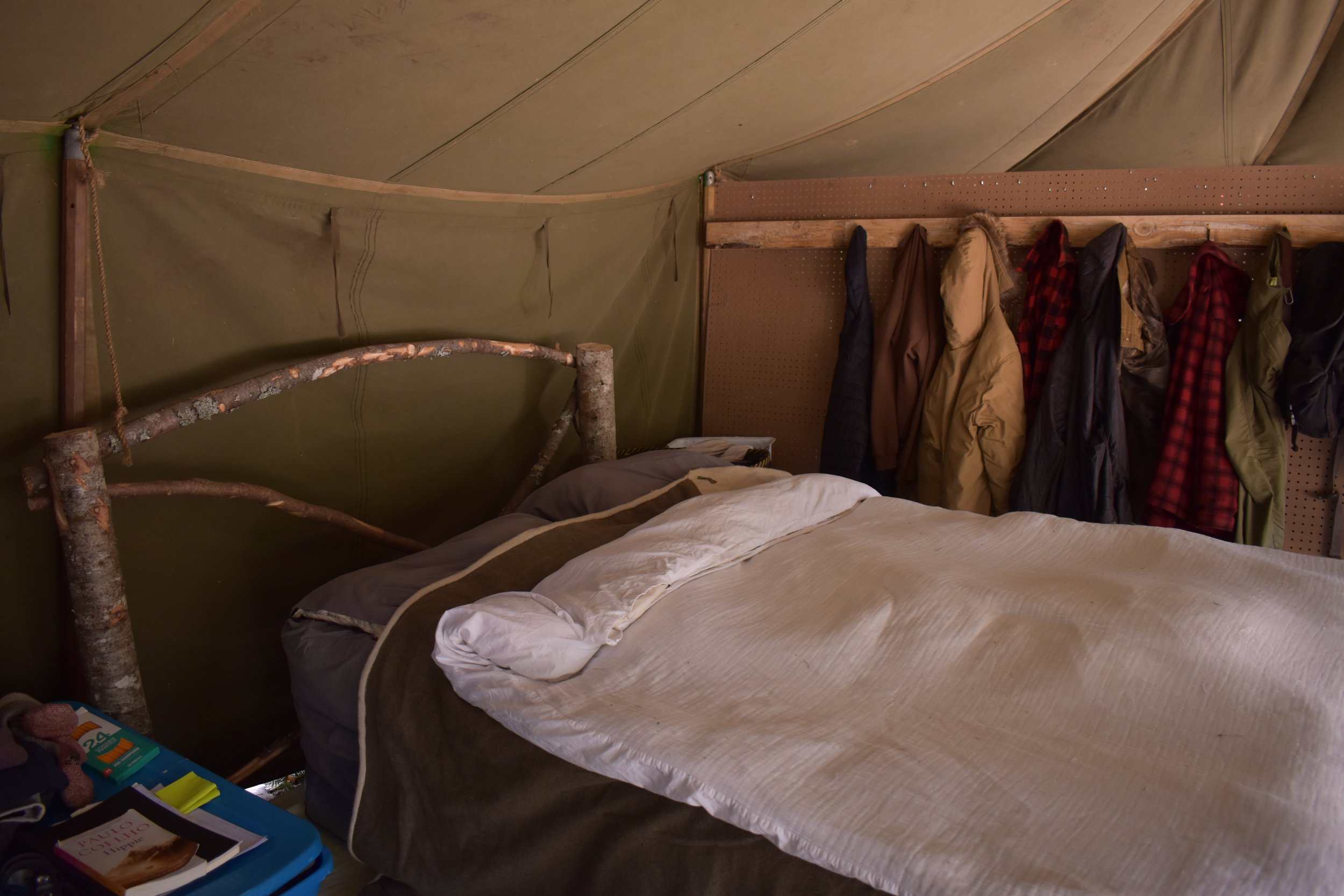

We made light of the situation as much as we could, joking about our “jello bed” air mattress that deflated nightly and our intimacy-inhibiting sleeping bags dubbed the “stink tubes.” I made a game of how many times a day I had to pull in bedding from drying out in the rain. In months to come, we pretended the mosquito larva inhabiting our pollen-caked rainwater catchment were pet sea monkeys. Mike made songs about the black flies that chewed up my face and poetry about his black boogers caused by an unbearably dusty tent floor.
We got a good laugh from watering our earthen floors during the extremely dry spring. But I guess the ultimate joke was on us when the drought finally broke....along with all of the tent’s seams. Yes, it proceeded to rain multiple inches inside the tent while we tried to sleep. But even worse were the days after when EVERYTHING we owned exploded in mold. There was one upside. Our storage bins levitated off the ground, emergent mushroom raising them inches above the tent floor.
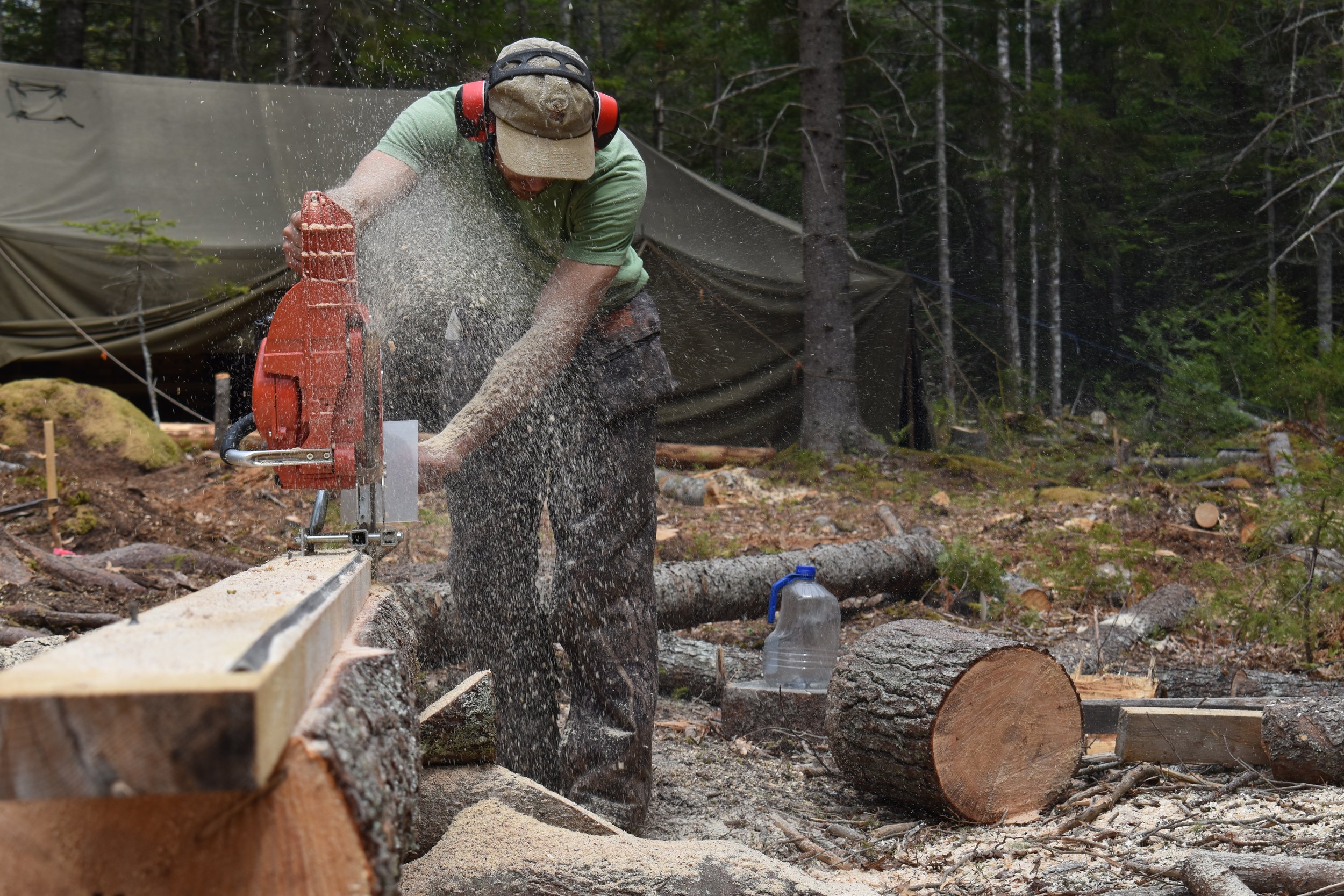
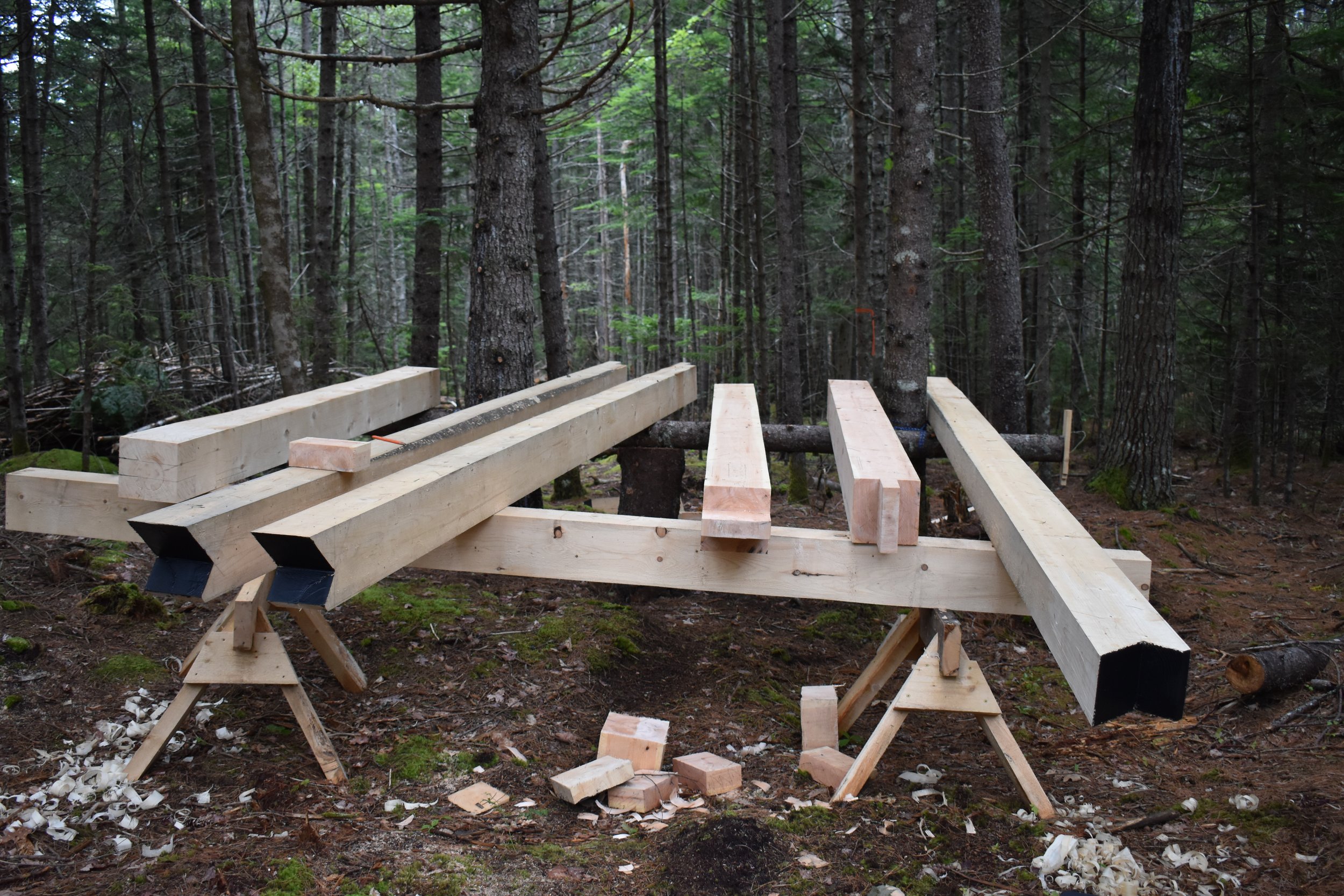

Month 2
When we arrived in Maine, we had yet to decide what to build for a home. We needed a livable house by the first winter, so time was not on our side. Still, we allowed the landscape to influence our decision as we identified the house site, cleared land, set up the tent, and acquired materials.
Between the time we budgeted for the build and were ready to begin procuring supplies, the price of lumber had skyrocketed, a symptom of the pandemic’s supply chain woes and a construction boom. We couldn’t afford to build with store-bought lumber, so we made our own. Mike, now a chainsaw pro, bought an attachment for the gas saw that would allow us to mill timbers. We also purchased timber frame plans online and then learned how to make sense of them. We bought chisels, mortisers and planers. More experienced friends arrived at each new stage of the process to teach us the skills needed to take a tree to a timber and turn timbers into a home.
Month 4
There was purity in our return to the basics of living. To prioritize our approach, with each phase of progress, Mike repeated out loud the order of survival: Shelter, Water, Fire, Food. Some days did feel like survival, but in pushing our boundaries we learned to be more comfortable in the discomfort.
I settled into the rhythms and routines of hard work. Our new way of living became an exercise in presence. The future had to be narrowed to only a few days at a time, otherwise the hugeness of the undertaking was paralyzing. My whole world shrunk to the size of the construction site. I lacked the capacity for anything beyond the scope of my immediate surroundings.


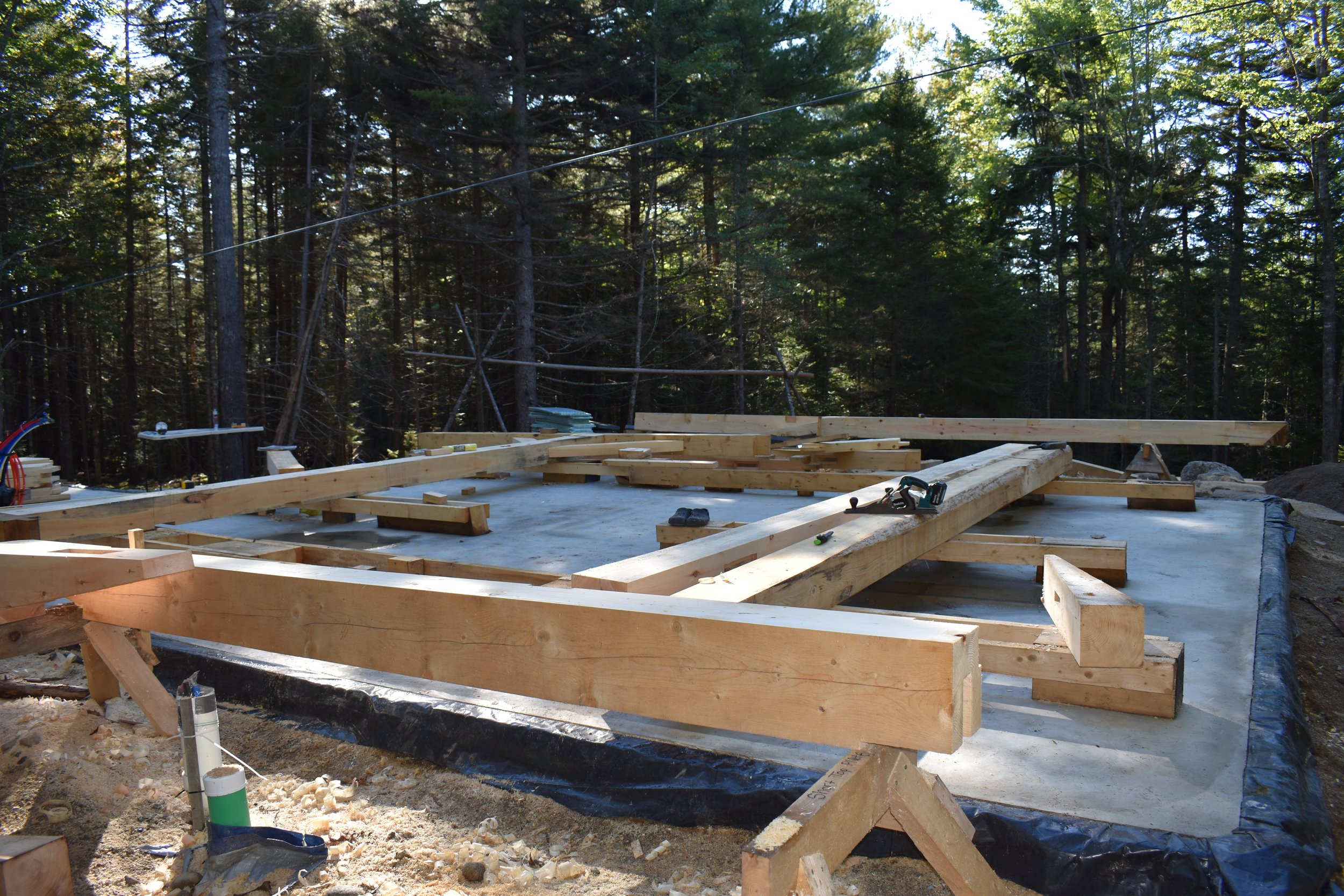
With this, a direct connection began to form between me and the land. The physical labor was exhausting, but it also seemed to have a purifying effect. I found great purpose in the singular focus, and the drudgery that used to characterize my office days was gone, and so were my headaches.
There was a new intimacy in my relationship with the earth elements. Our schedules were arranged around weather, we woke to bird songs in the morning, and slept deeply in the quiet dark. The tangled mess of forest began to take on a grace beyond imagination. I found joy in anticipating what it could look like in 10 years to come, in 50 years, and the years beyond me. Our new lifestyle had an even more positive effect on my relationship with Mike.
Although we existed in a state of complete vulnerability, with no space between, we were living the best version of ourselves and sharing in it fully.
Month 6
There was much ridiculousness about the whole adventure, and the absurdity only continued to escalate half a year in. We abandoned our tent most nights, unable to tolerate the inhabiting mold. Instead, we plopped the air mattress on our concrete pad and slept without cover. Sometimes we got rained on in the night, but we still found this preferable to the alternative. One morning around first light, an owl flew so close to me I could feel her wing beats.
About this time, the timbers needed to be moved to the homesite, some of which were hundreds of yards in the forest and weighed more than 1000 pounds each. Luckily, we have friends even crazier than us. A mighty work party of 16 barefoot hippies was assembled to hand carry the colossal timbers. When it came to carving the joinery and assembling the frame, every day tested our minds and bodies. With no one to step in for our mistakes, there were few opportunities to let our guard down. That said, I am not the impassive type. I referred to the 64 timbers as my 64 stages of grief. With each one, I expressively passed through an equal number of emotions, many of which psychologists haven’t even named.
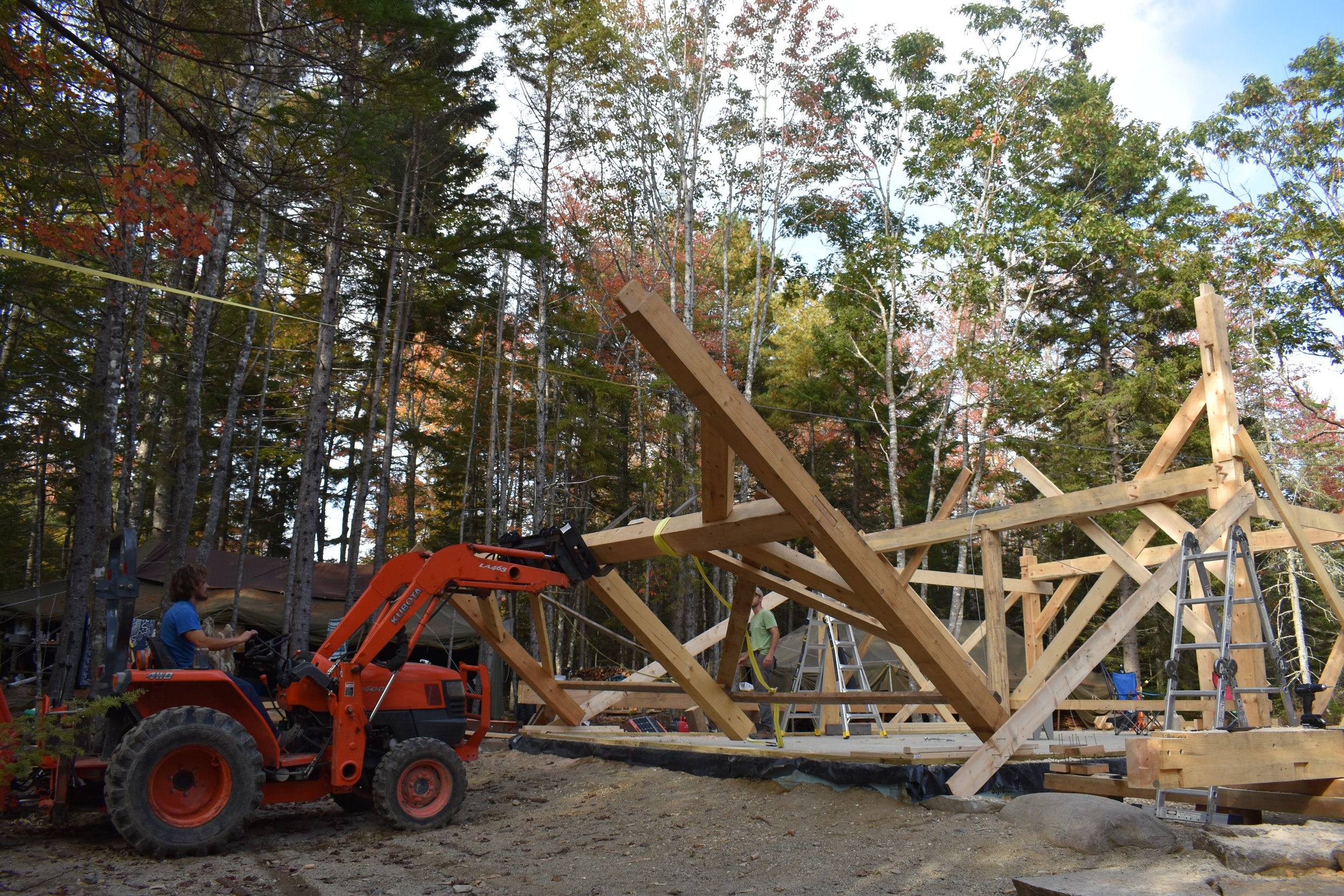


Month 8
Despite our best efforts to fight it off, winter eventually arrived. We gave our everything from March to October and then tapped into an unknown reserve, slogging through the last two months of the year in sub-freezing temperatures.
I purchased clothes from RefrigiWear, a company specializing in apparel for people who work in walk-in freezers or the actual artic. We employed a blow torch to thaw scaffolding, built a fire on top of bricks to separate them, and tried to convince the adhesive weather barrier to become sticky again with a hair drier. I was gifted 30 minutes of luxury every morning. Before the sun came up, I would sit in my car, blast the heater and sip coffee until I could feel my toes again.
We achieved our ambitious goal of enclosing the house before the REAL Maine winter set in, but without a heat source and proper insulation, it wasn’t yet livable. Having long ago reached our limit with the tent, multiple neighbors stepped in to help us in our time of need. (Nothing teaches the humility of acceptance like a matter of survival.) So we passed a slow and restful winter in the cozy cabin a mile down the road, occasionally working on our own home whenever temperatures were mild enough to allow, otherwise playing board games, cooking hearty meals, and reading by the fire.

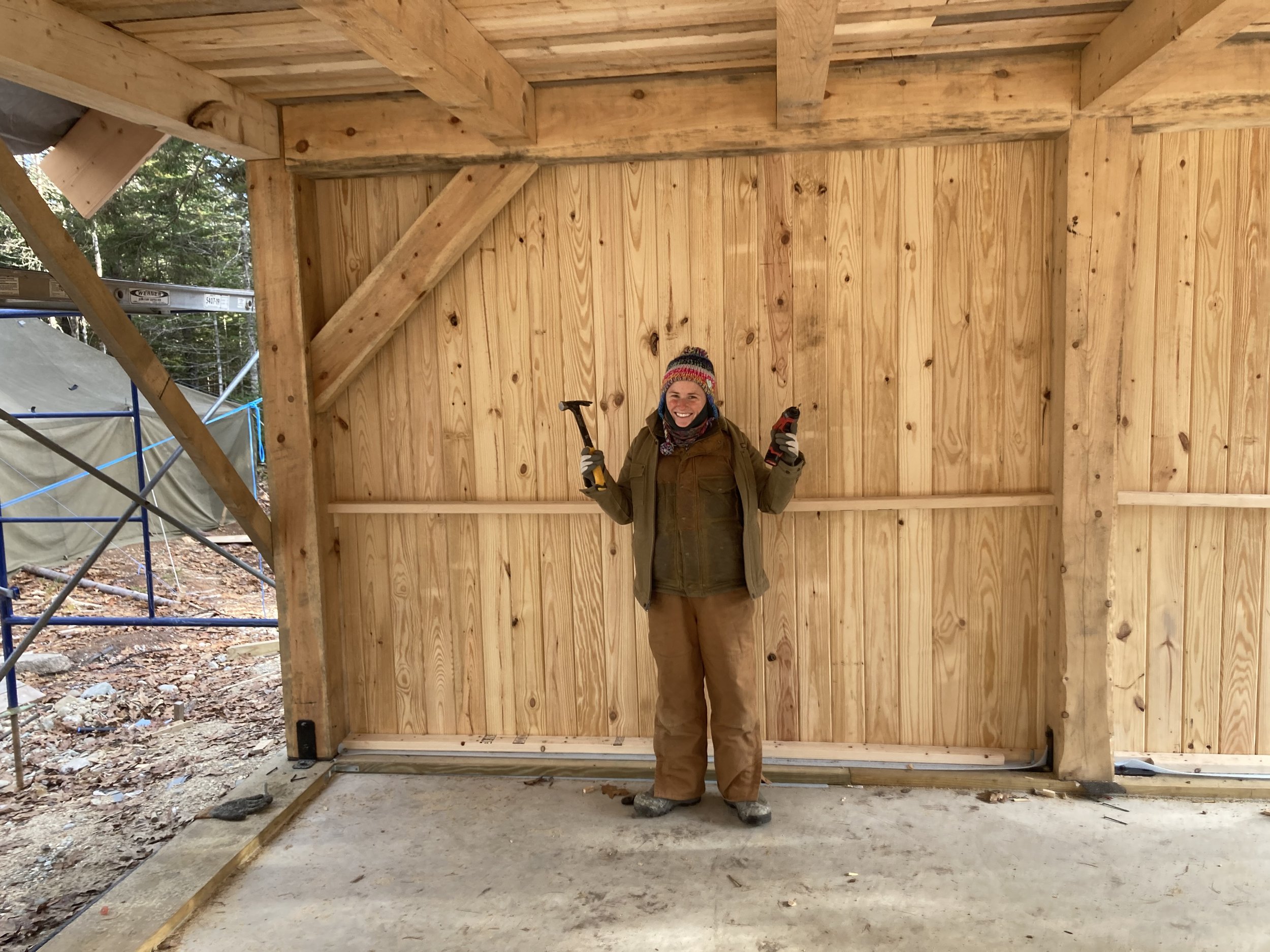
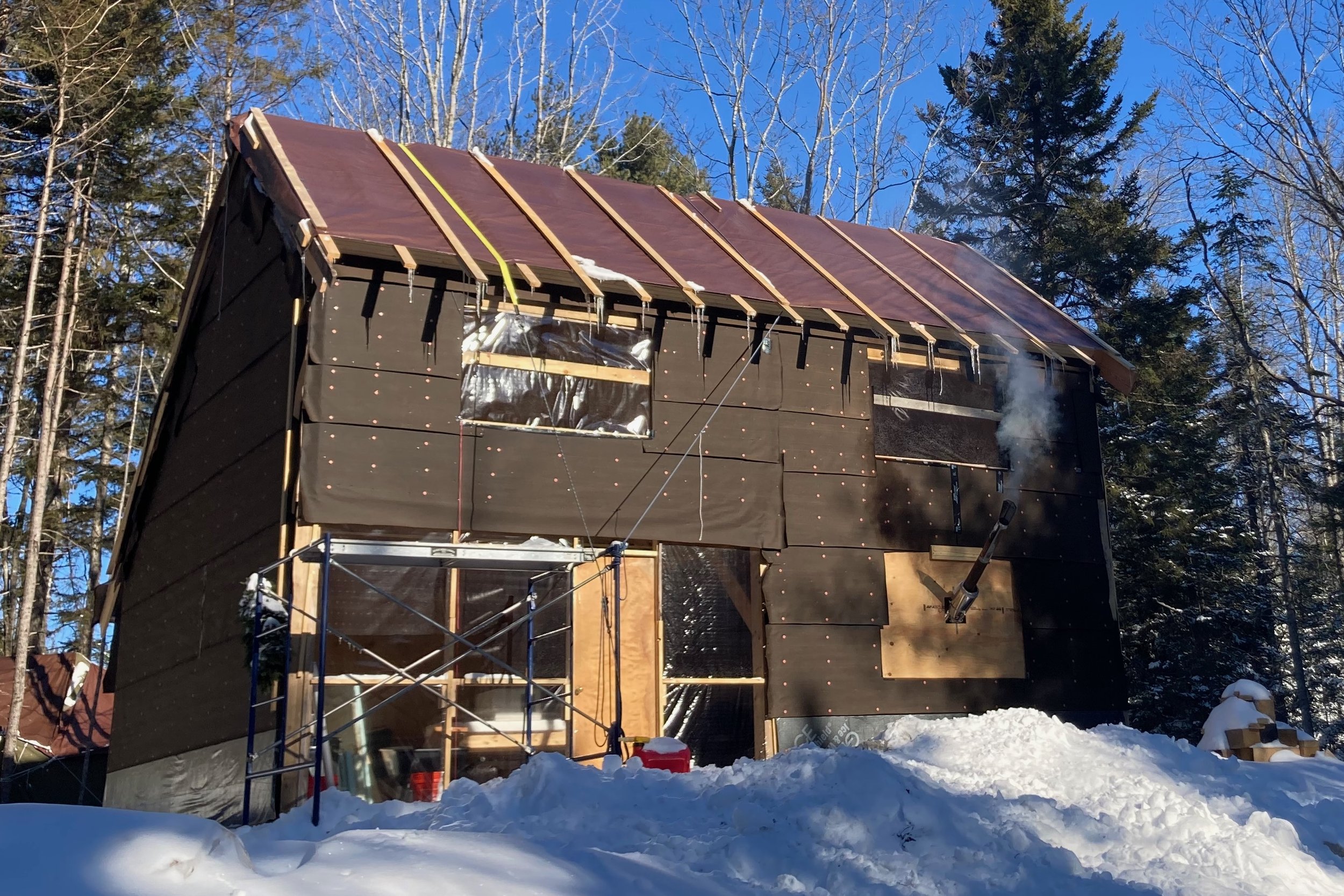
Year 1
We often look at our house and question if we really built it ourselves. Despite the countless hours, physical exertion, and diligent research, it feels like the home materialized of its own accord. Perhaps this is because we initially lacked the skills to believe the undertaking was possible, or because the process was such a day-to-day affair, or maybe because the frame was born from the surrounding woods.
The house retains a feeling of being alive, with a creative direction of its own. Every post and beam in the house has a story – some long before us, others we share. Point to any timber, and Mike or I can tell you where it came from, how we moved it, and the ease or difficulties with which we carved, planed, and assembled it.
Looking through photos of last year’s build brings a sense of accomplishment, disbelief, and immense relief. These were among the most memorable and unifying months of Mike and I’s relationship, but I am not sure either of us would sign up for it again. We are so in love with the house we built with our own hands and even more in love with one another.
Mike and I still have a long way to go, but we know the most challenging parts are behind us. As we begin to pick up our heads and celebrate the year’s achievements, we are reimagining the beauty of the future ahead. We cannot wait to invite others onto our land and into our home to share in the joy of outdoor adventure.
Story by: Amanda Hayley
